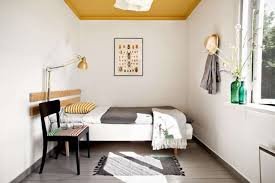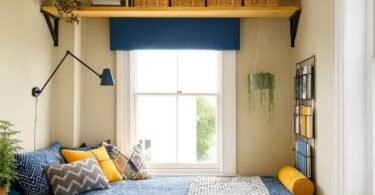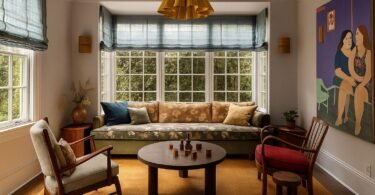You know that feeling when you walk into a tiny room and your shoulders instinctively scrunch up? Yeah, we’ve all been there. Small spaces have this weird way of making us feel boxed in, like we’re living inside a shipping container rather than an actual home. But here’s the thing I’ve learned after years of living in apartments where the bedroom was barely bigger than a walk-in closet: size really doesn’t matter as much as we think it does.
I remember when I first moved into my studio apartment in the city. The bedroom area, if you could even call it that, was about 10 feet by 10 feet. My mom came to visit and literally laughed when she saw it. “You’re going to live here?” she asked, trying not to sound too horrified. But you know what? That tiny space became my sanctuary. I learned tricks and techniques that completely transformed how I thought about small spaces. And that’s exactly what I want to share with you today.
We tend to write off small bedrooms before we even give them a chance. When you’re house hunting or apartment searching, the first thing people do is measure the master bedroom. If it’s not big enough to fit a California King and two nightstands with room to spare, we cross it off the list. But this knee-jerk reaction means we’re missing out on some seriously great living situations. A small bedroom can wrap around you like a cozy blanket. It can feel intimate and personal in ways that cavernous rooms never do.
Think about it this way: some of the most expensive hotel rooms in the world aren’t huge. They’re just really well designed. The difference between a cramped bedroom and a cozy one often comes down to how you arrange things, what colors you use, and whether you’re willing to think outside the box a little. I’ve seen 200-square-foot bedrooms that feel more spacious than 400-square-foot ones, and it all comes down to smart choices.
The beauty of working with a small bedroom is that every decision matters. You can’t just throw furniture at the problem and hope it works out. You have to be intentional. You have to think about what you actually need versus what you think you’re supposed to have. And honestly? That limitation can be freeing. When you can’t have everything, you start figuring out what really matters to you.
I’ve helped friends transform their tiny bedrooms from cluttered disaster zones into spaces they actually want to spend time in. The transformations are always amazing to watch. Someone who swore they needed a bigger place suddenly realizes their small room works perfectly when it’s set up right. They stop fantasizing about moving and start appreciating what they have. That shift in perspective is worth more than an extra hundred square feet any day.
So let’s get into the practical stuff. I’m going to walk you through everything you need to know about making a small bedroom work for you. We’re talking layout strategies, furniture choices, color schemes, and all those little details that add up to make a big difference. Whether you’re dealing with a kid’s room, a guest bedroom, or your own personal space, these principles apply across the board. Ready to make your small bedroom feel twice its actual size? Let’s go.
Understanding Your Bedroom Space
Before you buy a single piece of furniture or pick up a paintbrush, you need to get real about what you’re working with. I mean really real. This isn’t the time for wishful thinking or pretending that corner is bigger than it actually is. You need cold, hard measurements, and you need to understand how your space functions as a living area.
Grab a tape measure and start documenting everything. And I mean everything. Measure the length and width of your room, sure, but don’t stop there. Measure the height of your ceilings because that vertical space matters more than you think. Measure the width of your doorway because you need to know what furniture can actually fit through it. I once ordered a perfect dresser online, only to discover it was two inches too wide to make it through my bedroom door. That was a fun afternoon of trying to return furniture that wouldn’t fit in my car either.
Measure where your windows are and how much space they take up. Note where your electrical outlets are located because you’ll need to plug in lamps, charge your phone, maybe run a fan in the summer. Mark where the closet door swings open and how much floor space it takes up when it does. These details seem boring, and I’ll be honest, they kind of are. But they’re the difference between a bedroom layout that works and one that has you stubbing your toe every morning.
Now here’s where it gets fun. Take a blank piece of paper and sketch out your room. You don’t need to be an architect or an artist. Stick figures and boxes work just fine. Draw the walls, mark where the door is, show where the windows are located. This bird’s eye view is going to be your best friend for the next few weeks as you figure out your layout.
Some people like using graph paper for this, and honestly, that’s not a bad idea if you want to get precise with your measurements. One square equals one foot, and suddenly you’ve got a scale drawing that actually means something. But even a rough sketch on notebook paper will do the job. The point is to visualize your space from a different angle than you’re used to seeing it.
Once you’ve got your basic floor plan drawn out, start playing around with furniture placement. Draw rectangles for your bed, your dresser, your nightstand. Move them around on paper before you start shoving heavy furniture around your actual room. This saves your back and your sanity. You might discover that your bed works better on the opposite wall than where you thought it should go. You might realize you have room for a reading chair if you ditch that bulky dresser and use a tallboy instead.
This planning phase is where you get to dream a little. What do you actually want your bedroom to feel like? Do you want it to be a peaceful retreat where you can escape from the world? Do you need it to double as a workspace during the day? Are you trying to create a romantic vibe or a productive one? These questions matter because they’ll guide every choice you make from here on out.
I spent a whole weekend once just sitting in my bedroom at different times of day, noting how the light changed, where shadows fell, which corner stayed coolest in the afternoon. My roommate thought I’d lost it, but that observation time taught me so much about my space. I learned that the morning sun came in strong on the east wall, which meant I didn’t want my bed there unless I wanted a natural alarm clock at 6 AM. I noticed the northwest corner stayed darker and cooler, perfect for a small reading nook.
Pay attention to your room’s quirks too. Does one wall get really cold in winter because it faces outside? That’s not where you want your bed. Is there a radiator or heating vent somewhere? Don’t block it with furniture. Does your room share a wall with a noisy neighbor or a busy street? You might want to put your bed on the quietest wall so you can actually sleep at night.
Think about traffic patterns too. How do you move through your bedroom? Do you need to access your closet multiple times a day? Then don’t put furniture in front of it that you’ll have to move every time you need to grab a shirt. Do you tend to drop your clothes in a pile at the end of the day? Maybe plan for a hamper or chair in that spot so at least the pile is intentional.
The goal here is to understand your space so well that you can make informed decisions about it. You’re not just decorating a room. You’re designing a functional living space that needs to work for your actual life, not some idealized version of life you saw in a magazine. Your bedroom needs to handle your habits, your schedule, your stuff, and your personal weird quirks that make you who you are.
Choosing the Right Furniture

Alright, let’s talk about furniture, because this is where most people mess up their small bedrooms. They try to cram in everything they think a bedroom should have, and they end up with a obstacle course instead of a relaxing space. The secret to furniture in a small bedroom is simple but hard to follow: less is more, and everything needs to earn its place.
Start with your bed because, duh, that’s the main event. But here’s where you need to think differently than you might in a larger room. In a small bedroom, your bed can’t just be a bed. It needs to work harder than that. Platform beds with built-in storage underneath are absolute game changers. I’m talking drawers that slide out, or a lift-up mattress that reveals a huge storage cavity. You can stash off-season clothes, extra bedding, shoes, whatever you need to hide away.
Loft beds aren’t just for kids or college dorms anymore. If you’ve got the ceiling height, raising your bed up creates this whole usable space underneath. You could put a desk there and create a work area. You could add a cozy chair and make a reading nook. You could even fit a small dresser or shelving unit. The vertical space in your room is prime real estate that most people completely ignore.
Murphy beds, or wall beds, or whatever you want to call them, have come a long way from those creaky contraptions your grandparents had. Modern versions are smooth, easy to operate, and they don’t look like hospital equipment. During the day, your bed disappears into the wall and suddenly you’ve got floor space for yoga, or dancing, or just walking around without feeling cramped. At night, you pull it down and you’ve got a real bed with a real mattress. I have a friend who converted her studio apartment with one of these, and she went from feeling like she lived in a bedroom to feeling like she had an actual apartment.
Nightstands are tricky in small spaces. The traditional matching nightstands on either side of the bed? That might not work for you, and that’s okay. A single small nightstand on one side might be enough. Or you could mount floating shelves on the wall next to your bed instead. These take up zero floor space, which makes your room feel bigger, and they still give you somewhere to put your phone, a glass of water, and whatever book you’re pretending you’ll read before bed.
Wall-mounted lights instead of table lamps free up surface space on those nightstands or shelves. Swing-arm lamps are perfect for reading in bed, and they don’t require any furniture to sit on. Just screw them into the wall and you’re done. Same goes for charging stations. Get a power strip with USB ports and mount it on the wall or the back of your nightstand. Your phone charges overnight without taking up precious flat surface space.
Dressers are bulky space hogs, let’s be real. A standard six-drawer dresser takes up a huge footprint in a small room. But you need somewhere to put your clothes, right? Think vertical with a tallboy dresser instead. Same amount of storage, half the floor space. Or skip the dresser altogether if you’ve got decent closet space. Sometimes a few well-organized shelves or a hanging closet organizer can replace a dresser completely.
Multi-purpose furniture is your best friend in a small bedroom. An ottoman that opens up for storage and doubles as seating? Perfect. A bench at the foot of your bed where you can sit to put on shoes, but it also lifts up to store extra blankets? Yes, please. A desk that folds up against the wall when you’re not using it? Absolutely. Every piece of furniture should do at least two jobs if it wants to stay in your room.
Let me tell you about the time I tried to fit a regular desk in my small bedroom. I thought I needed a proper workspace, so I bought this nice desk with drawers and everything. It took up so much room that I could barely walk around my bed. I kept bumping into the desk chair. The room felt cramped and messy no matter how much I cleaned. Finally, I admitted defeat, sold the desk, and mounted a fold-down desk to the wall instead. The difference was dramatic. When I’m not working, the desk disappears. The room feels open again. And I still have a perfectly functional workspace when I need it.
Be ruthless about furniture that’s not serving you. That chair in the corner that’s covered in clothes? If you’re not actually sitting in it, get rid of it. That extra side table you thought you needed? If it’s just collecting junk, it’s gotta go. Small spaces require discipline. You can’t keep furniture around just because you think you’re supposed to have it or because it was expensive or because your mom gave it to you. If it’s making your bedroom feel cramped and you’re not using it, out it goes.
Scale matters too. Furniture that’s too big for your room will make everything feel off, like when you see a Great Dane living in a studio apartment. Measure your furniture before you buy it, not just the room. Think about proportion. A king-size bed in a 10-by-10 room is going to overwhelm the space, even if it technically fits. A full or queen might serve you better and actually make the room more livable.
Shop with a plan. Don’t just wander into a furniture store and fall in love with something without knowing if it’ll work. Bring your measurements. Bring your floor plan sketch. Take pictures of your space on your phone so you can compare colors and styles while you’re shopping. I’ve saved myself from so many buying mistakes by pulling up a photo and realizing that cute nightstand is completely the wrong color for my walls.
Working With Color
Color is magic in a small bedroom. I’m not even exaggerating. The right color palette can make your room feel twice as big, while the wrong colors can make it feel like the walls are closing in. And the best part? Paint is cheap. If you mess up, you can fix it for the cost of another gallon and an afternoon of work.
Light colors reflect light, which makes spaces feel more open and airy. This is basic physics, but it’s also design gold. White walls are the classic choice for small spaces, and there’s a reason for that. White bounces light around the room, making it feel brighter and more spacious. But here’s the thing: not all whites are created equal. Some whites lean blue, some lean yellow, some have gray undertones. You need to test paint samples on your actual walls and look at them in different lighting before you commit.
Pale blues, soft grays, gentle greens, light lavenders… these are all solid choices for small bedroom walls. They give you some color personality without making the space feel heavy or dark. I painted my bedroom this really pale, almost-not-even-there blue-gray once, and people would walk in and say it felt bigger than it actually was. That color created this calm, expansive feeling that white somehow didn’t quite achieve.
Pastels get a bad rap sometimes because people associate them with nurseries or Easter eggs, but modern pastels are sophisticated and grown-up. A muted sage green or a dusty pink or a soft peachy beige can add warmth to a small room without overwhelming it. The key is to go for tones that are grayed down a bit, not the bright, saturated pastels of childhood.
Now, dark colors in a small room aren’t totally off the table, but you’ve got to use them carefully. An accent wall in a deeper color can actually add depth and interest to a small space. The wall behind your headboard is a perfect spot for this. You could go with a rich navy, a deep charcoal, maybe even a moody forest green. This gives your eye a focal point and creates the illusion of depth, like the wall is receding.
The mistake people make with dark colors is using them on all four walls in a small room. That’s when you start feeling like you’re living in a cave. One dark wall creates drama and interest. Four dark walls create a dungeon. Learn from my mistakes here. I once painted my entire small bedroom a deep chocolate brown because I thought it would feel cozy. It felt cozy all right… cozy like a coffin. I repainted within a month.
Monochromatic color schemes work beautifully in small bedrooms. Pick one color and use different shades and tints of it throughout the room. Maybe your walls are pale gray, your bedding is medium gray, and you’ve got charcoal gray throw pillows. This creates a cohesive, pulled-together look that doesn’t feel busy or chaotic. Your eye moves smoothly around the room instead of jumping from color to color.
Color doesn’t just mean paint though. Your bedding, your curtains, your rug, your artwork… all of these contribute to the overall color story of your room. In a small space, you want these elements to complement each other, not compete. That doesn’t mean everything has to match perfectly, but there should be a sense of harmony.
White or light-colored bedding is a smart choice for small bedrooms. It keeps things feeling fresh and open. You can always add pops of color with throw pillows or a blanket at the foot of the bed. These smaller color elements are easy to change out when you get bored, which you will, because that’s just how decorating works. You love something intensely for six months, then suddenly you can’t stand looking at it.
Curtains deserve special attention in small bedrooms. Heavy, dark curtains make windows feel smaller and block light even when they’re open. Light, sheer curtains let natural light filter in, which brightens your space and makes it feel more open. If you need blackout curtains for sleeping, look for light-colored ones. Yes, they make blackout curtains in white and cream. You don’t have to choose between sleeping and having a light, airy room.
Mirrors are technically not color, but they work with light in similar ways, so I’m including them here. A large mirror in a small bedroom reflects light around the room and creates the illusion of more space. Position a mirror across from a window, and suddenly you’ve got light bouncing everywhere. It’s like adding a second window without the construction costs.
I hung a full-length mirror on the back of my bedroom door once, and I swear it made the room feel 20% bigger. Every time I opened the closet or looked across the room, I’d catch the reflection and think the space continued beyond where it actually ended. This is a cheap trick that works surprisingly well.
Color temperature matters too. Warm colors (reds, oranges, yellows) tend to advance visually, making walls feel closer. Cool colors (blues, greens, purples) recede, making walls feel farther away. For a small bedroom, cool colors generally serve you better. They create that sense of spaciousness we’re after.
But rules are made to be broken, right? If you absolutely love warm colors and cool tones make you feel sad, then use warm colors. Just maybe stick to lighter, less saturated versions. A peachy cream instead of bright orange. A soft buttery yellow instead of school bus yellow. You get the idea.
Ceiling color is something most people never think about, but it matters. The standard move is to paint your ceiling white, and that works fine. White ceilings feel higher, which makes the room feel bigger. But you could also paint your ceiling the same color as your walls, which makes the boundaries of the room less defined and can actually make the space feel larger. I tried this once with a pale blue, and the room felt like it opened up into the sky. A little weird, but in a good way.
The bottom line with color in small bedrooms is this: test everything before you commit, go lighter rather than darker in most cases, and create a cohesive color story that doesn’t overwhelm the space. Your bedroom should feel calm and spacious, not chaotic and cramped. Color is one of your most powerful tools for achieving that feeling.
Lighting Your Small Space

Let’s talk about lighting, because this is where small bedrooms can either shine (pun intended) or fall completely flat. Bad lighting makes any room feel depressing, but in a small space, it can make things feel downright claustrophobic. Good lighting, on the other hand, opens up your room and makes it feel welcoming and functional.
Natural light is the absolute best, and you want to maximize whatever you’ve got. Keep your windows as clear as possible. Those heavy curtains we talked about earlier? Keep them pulled back during the day. Let the sunshine in. Natural light makes small spaces feel connected to the outside world, which creates a sense of openness even when your actual square footage is limited.
If you’re lucky enough to have a window, treat it like the precious resource it is. Don’t block it with furniture if you can help it. Position your bed or your desk to take advantage of the natural light without putting them directly in front of the window. You want the light to flow into the room, not get blocked by a big piece of furniture.
No window, or a really small window? That’s trickier, but not impossible. You just need to be smarter about your artificial lighting. The key is to use multiple light sources at different heights rather than relying on one overhead light. This creates depth and makes the space feel more interesting and less flat.
Overhead lighting is fine for general illumination, but it’s usually pretty harsh and unflattering. If you’re stuck with a standard ceiling light fixture, swap out the bulb for something warmer and less intense. You want light that’s bright enough to see by but not so bright it feels like an interrogation room.
Table lamps on nightstands or dressers add warm, localized light that makes a room feel cozy. But in a small bedroom, you might not have space for table lamps. That’s where wall-mounted lights come in clutch. Sconces on either side of your bed serve the same purpose as table lamps but don’t take up any floor or surface space. Win-win.
Floor lamps are hit or miss in small bedrooms. They can work if you’ve got an empty corner that needs some light, but they can also become another obstacle to navigate around. If you do go with a floor lamp, get one with a slim profile that tucks into a corner and doesn’t stick out into your walking path.
String lights get dismissed as juvenile sometimes, but hear me out. Good quality string lights with warm-toned bulbs can create a soft, ambient glow that makes a small bedroom feel magical. Drape them along a wall, around a mirror, or across your headboard. They’re not your primary light source, but they add atmosphere and make the space feel intentional and designed.
Under-bed lighting is a weird trick I learned from a friend who’s really into smart home stuff. LED strips under your bed frame create this floating effect that actually makes the room feel bigger. The light doesn’t illuminate much practically speaking, but it creates the illusion that your furniture isn’t sitting heavy on the floor. Your bed looks lighter, the room feels more spacious. Strange but true.
Task lighting matters if you use your bedroom for anything besides sleeping. Reading light by your bed, a desk lamp if you work in your room, good lighting near your closet for picking out clothes… these targeted light sources make your space more functional. You don’t want to be squinting to read or struggling to see if your socks match.
Dimmer switches are worth the small investment and easy installation. Being able to control the brightness of your lights means you can have bright light when you’re getting ready in the morning and soft light when you’re winding down at night. One light fixture, multiple moods. Small bedrooms benefit from this flexibility because you can’t usually dedicate different areas to different activities.
Light bulb color temperature is technical but important. Warm white bulbs (2700K to 3000K) create a cozy, relaxing atmosphere perfect for bedrooms. Cool white or daylight bulbs (5000K+) feel harsh and clinical, better suited for offices or garages. Check the packaging when you buy bulbs. You want warm white for your bedroom, trust me on this.
Candles count as lighting, right? They’re not practical as your main light source, but they add ambiance and make a room feel special. Just be careful with them in small spaces. You don’t want to knock a candle over because everything is crammed together. Battery-operated LED candles have come a long way and don’t carry the fire risk. I use them sometimes, and honestly, guests usually can’t tell they’re fake.
Maximize the light you have with reflective surfaces. We talked about mirrors earlier, but glossy furniture finishes, metallic picture frames, even satin-finish bedding can help bounce light around your room. Matte surfaces absorb light, while shiny surfaces reflect it. In a small, darker bedroom, every bit of reflected light helps.
Pay attention to lamp shades too. Dark or colored shades block light and make your lamps less effective. White or cream shades allow more light through and distribute it better. Drum shades tend to direct light more downward, while empire shades spread it in more directions. These details seem picky, but they affect how well your lighting actually works.
The goal with lighting in a small bedroom is to create layers. Ambient light for general visibility, task lighting for specific activities, and accent lighting for mood and atmosphere. When all these layers work together, your small room feels well-lit without being harsh, functional without being boring, and cozy without being dark. That’s the sweet spot we’re aiming for.







Leave a Comment